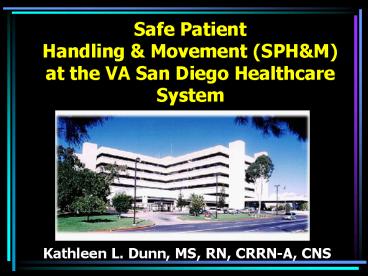Safe Patient Handling PowerPoint PPT Presentation
1 / 36
Title: Safe Patient Handling
1
Safe Patient Handling Movement (SPHM) at the
VA San Diego Healthcare System
- Kathleen L. Dunn, MS, RN, CRRN-A, CNS
2
Where we were in 2000
- Most patient movement was being done manually.
- Some areas had 1 mobile lift, which was rarely
used. - Nurse injuries were frequent costly.
- SCI had highest nurse injury rate in the entire
hospital.
3
Transfers such as quad pivots, 2-person lifts,
and 2 person sheet pulls were common.
Quad Pivot
Sheet Pull
2-person lift
4
Where we were in 2000
- Traditional body mechanics training was included
in orientation and reviewed annually. - Those injured were required to repeat this
training.
5
February-April 2001
- VASDHS staff attended VISN 8 Safe Patient
Handling Movement Conference. - We saw the light!
- Solicited support for program
within Nursing Service - Presented to PIC approved for
PIT chartering.
6
Costs of Injuries FY02 VASDHS
- 30 nurse injuries associated with patient
handling and movement tasks - 17 occurred on the Spinal Cord Injury Center
resulting in 162,815.53 in charge back (direct)
costs. - With indirect costs being 4-10X that of direct,
it is estimated that in FY02, the SCI unit had
over 650,000.00 in costs related to nurse
injuries caused by patient handling and movement.
7
Fall 2001-Summer 2002
- Banned manual lifting (2 person lifts quad
pivots) on SCI unit. - Established SPHM committee.
- Collected pre-project baseline data.
- Planned and held 2 equipment fairs.
- Trial install of 4 ceiling track lift systems in
SCI over 2 months.
8
SCI Patient Room
9
SCI Inpatient RoomSingle-track ceiling lift for
two beds in one room.
Battery Charge position
Auto return to preset height.
Sling hook on bedside cabinet
10
SCI Inpatient Room Patients are issued a sling
at admission that stays on their bedside closet
hook.
11
Privacy Curtain Modifications
Curtains split Velcroed
12
SCI Clinic
13
SCI clinic exam room
14
SCI Therapy GymSingle-track ceiling lift over
P.T. parallel bars. Scales allow measurement of
weight bearing.
15
Use of Ceiling Track Lift for Suspended Gait
Training
16
Transverse-track ceiling lift over therapy mat
17
Cost Savings Phase 1
- 150,000 spent for Phase 1 (SCI) ceiling track
lift installation in October 2002. - October 2002-March 2003
- Zero (0) SCI nurse injuries related to transfers
or lifting. - 1 SCI nurse injury related to patient turning.
- Estimated costs savings 600,000 for Phase I
pilot
18
(No Transcript)
19
June-July 2003
- Presentation of Phase 2. proposal to Status of
Funds - Approximately 600,000 for equipment approved
for Phase 2.
20
October-December 2003
- Installation of Phase II
- Partial ceiling track lifts on all inpatient
units. - New mobile lifts obtained for most areas.
- No-Lift (SPHM) Nursing PCS Services Policy
approved. - Staff Education Training.
21
Strategies
- Develop Champions for culture change.
- VASDHS PINs
(Preventing Injuries Now facilitators).
Includes non-nursing staff as well. - Credible peer leaders.
- Ongoing hazard identification.
- Train-the-trainers.
- Implement algorithms in all units/areas.
PIN
22
Transfer to and from Bed to Chair Chair to
Toilet Chair to Chair or Car to Chair
Does the patient have UE strength?
23
Other Examples of Re-Engineering at the VASDHS
24
ICU Ceiling Track Lifts
25
Wall Mounted System in Med-Surg areas
26
Dialysis Ceiling Track Lifts
27
Radiology Ceiling Track Lifts
28
Morgue Lift
29
Where are we now?
- ALL OF VASDHS
- Complete total patient room ceiling track
install Spring 2007. - Radiology, MRI, cardiac lab, and Morgue
re-engineered. - Rarely-used equipment bank (Escort).
- Increased compliance and skill in use of
algorithms.
30
Where are we now?
- Before averaged 40 injuries a year due to
patient handling and movement. - Now average 20 injuries a year with just partial
implementation of the program. - Costs approx. 950,000 spent on equipment and
re-engineering. - Cost Savings 2.8 million (direct and indirect)
31
(No Transcript)
32
Where are we now?
- Policy is now applicable to all direct patient
care staff (not just nursing staff) as an MCM
(3/06). - List of banned manual handling tasks
- Universal requirement to use SPHM techniques and
equipment. - Staff, supervisor and administrative
responsibilities detailed.
33
Where are we now?
- Radiology, Rehab Medicine, and other services
represented on Committee, which now reports to
Process Improvement Council (PIC). - On-going education monitoring.
- Plans to have input on all patient care equipment
purchases from ergonomic stand-point.
34
Where are we now?
- VA National Directive mandating SPHM is expected
this summer. - Additional 336,000 received as VACO grant for
projects through FY 08 - SPHM Facility Champion position will be
implemented by start of FY 09.
35
VASDHS Safe Patient Handling Movement MCM
- Defines responsibilities at all levels.
- Applies to all clinical staff.
- Lists banned patient/equipment handling
movement activities. - Defines possible consequences for staff failure
to follow this policy these rules. - Contains decision making algorithms.
36
Thank You for Your Attention!

